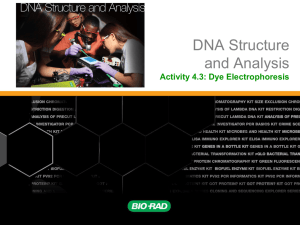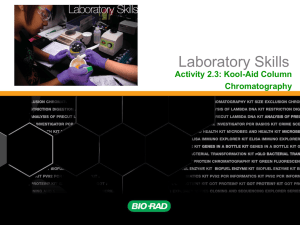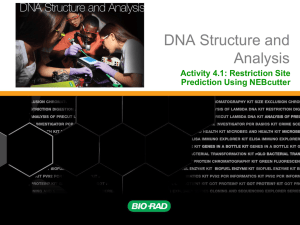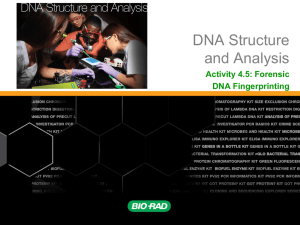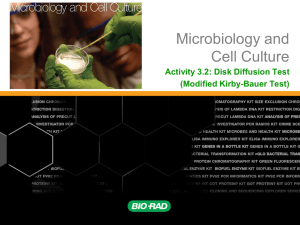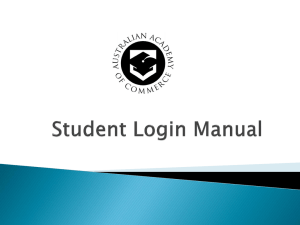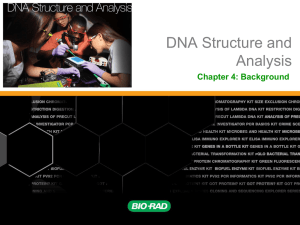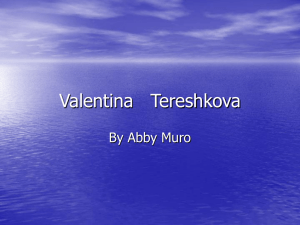Rapid Stain-Free Western Blotting with the V3 Western - Bio-Rad
advertisement
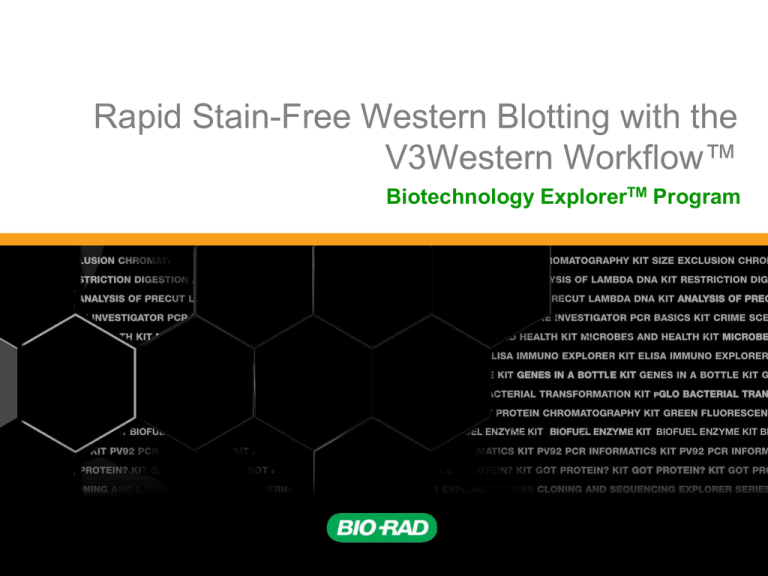
Rapid Stain-Free Western Blotting with the V3Western Workflow™ Biotechnology ExplorerTM Program Rapid V3 Stain-Free Western Blotting Workshop Outline 2 Introduction to Rapid Blotting and V3 Stain-Free Protein Gel Electrophoresis Stain-Free Gel Activation Western Transfer Stain-Free Gel/Blot Imaging Block nitrocellulose membrane Incubation with antibody solutions Color development of the blot Biotechnology Explorer™ | explorer.bio-rad.com Rapid Western Blotting + V3 Stain-Free A new approach to western blotting workflows – Rapid • Faster electrophoresis times • Faster protein transfer times • Faster protein visualization – Higher Throughput • More gels transferred in a single blotting unit – Real Time Monitoring of Experiment using Stain-Free Technology • Monitor protein separation prior to transfer • Monitor protein transfer prior to blot probing 3 Biotechnology Explorer™ | explorer.bio-rad.com Rapid Western Blotting + V3 Stain-Free Rapid Blotting 4 Biotechnology Explorer™ | explorer.bio-rad.com What is V3 Stain-Free? Visualize. Verify. Validate. – Separate Proteins • Electrophoresis with TGX gels – Visualize Separation • Stain-Free gel imaging – Transfer Proteins • Trans-Blot Turbo rapid transfer – Verify Transfer Visualize Separation Verify Validate Transfer Western • Stain-Free blot imaging – Validate Western Blot • Quantitation of results 5 Biotechnology Explorer™ | explorer.bio-rad.com Separate Proteins Transfer Proteins Western Transfer: Blotting Methods Methods to transfer proteins to solid support – Microfiltration • Used to capture proteins that are in solution, utilizes vacuum for protein immobilization onto membrane • Rapid due to lack of size separation step, but may be less informative – Diffusion/Capillary • Used to transfer proteins from gels, involves wicking of buffer through a weighted transfer stack, is very slow and can be inefficient for larger proteins – Electroblotting • Used to transfer proteins from gels, is much faster than diffusion, involves electrical current-mediated mobilization of protein through a buffer-saturated transfer stack • Several varieties including Tank (wet), Semi-Dry, and Rapid Semi-Dry 6 Biotechnology Explorer™ | explorer.bio-rad.com Western Transfer: Electroblotting Methods Tank (wet) blotting – Assemble transfer sandwich • Includes gel, membrane, filter paper – Place sandwich in non-conducting transfer cassette – Submerge cassette into tank filled with buffer that conducts electrical current provided by power supply to mobilize proteins from gel (cathode [-] side) to membrane (anode [+] side) – Large volume of buffer dissipates heat, but provides more resistance, so transfer takes longer 7 Biotechnology Explorer™ | explorer.bio-rad.com Western Transfer: Electroblotting Methods Semi-Dry blotting – Assemble transfer sandwich, which is pre-saturated in transfer buffer – Distance between electrodes is very small (only the width of the transfer sandwich) – Smaller volume of buffer decreases ability to dissipate heat, but also lowers resistance, allowing transfer to occur more rapidly 8 Biotechnology Explorer™ | explorer.bio-rad.com Western Transfer: Comparison of Electroblotting Methods Tank Blotting Semi-Dry Blotting Traditional 9 Rapid Transfer time 30 min – overnight 15 – 60 min 3 – 15 min Handling convenience Manual assembly of transfer components Manual assembly of transfer components Prepackaged, presaturated components Transfer parameters Widest range of power settings and transfer times Power and transfer time limited due to lack of cooling options Preinstalled, customizable programs, or userprogrammable settings Temperature control Cooling with ice pack or refrigerated water circulator None None Buffer requirement 1-12 L, system dependent 250 ml per blot No additional buffer required Biotechnology Explorer™ | explorer.bio-rad.com Trans-Blot Turbo Rapid Semi-Dry Blotting – The Easy-Bake oven of western blotting 10 Biotechnology Explorer™ | explorer.bio-rad.com Trans-Blot Turbo Rapid Semi-Dry Blotting – Advantages • • • • • 11 Rapid semi-dry system Preassembled membrane packs Bulk consumables are in the works Individual transfer trays = flexible start times Can transfer up to 4 Mini Gels at a time Biotechnology Explorer™ | explorer.bio-rad.com TGX Gel Technology – What is TGX? • TGX = Tris Glycine eXtended PAGE gels • Modification of traditional Laemmli system – What’s different from traditional SDS-PAGE gels? • Extended shelf life - gels stable for 12 months • Faster run times, because TGX gels can withstand higher voltages • More cost effective than traditional PAGE gels • Available in Stain-Free version 12 Biotechnology Explorer™ | explorer.bio-rad.com Stain-Free TGX Gels – How does Stain-Free chemistry work? • Gels contain a trihalo compound • Trihalo = triple halogen = 3 Chlorine, Bromine, Fluorine, or Iodine • UV light activates covalent reaction between trihalo compound and tryptophan residues in proteins • Reaction adds 58 Da moiety to tryptophans 58 Da UV light 13 Biotechnology Explorer™ | explorer.bio-rad.com Stain-Free TGX Gels – What’s the result of this reaction? • 58 Da moieties fluoresce under UV light • Allows protein visualization without staining – Will adding 58 Da to every tryptophan affect the apparent weight or mobility of my protein? • UV-induced linkage occurs after electrophoresis, so protein mobility is not altered 14 Biotechnology Explorer™ | explorer.bio-rad.com Imaging with the Gel Doc EZ – Easy to use, can perform a wide range of documentation and quantification functions • Automatic lane and band detection • Easy quantification of results – Auto control of filters, lens, or lights • System automatically focuses, adjusts filter, determines optimal exposure – Fast image acquisition with preset and customizable controls 15 Biotechnology Explorer™ | explorer.bio-rad.com Imaging Capabilities with Gel Doc EZ – Color coded trays for different uses 16 Biotechnology Explorer™ | explorer.bio-rad.com Rapid V3 Stain-Free Western Blotting Lab – – – – – 17 Run samples on Stain-Free TGX gels Visualize protein separation using Gel Doc EZ Transfer proteins to nitrocellulose using Trans-Blot Turbo Verify protein transfer using Gel Doc EZ Immunodetection for myosin light chain Biotechnology Explorer™ | explorer.bio-rad.com Comparative Proteomics Kit II: Western Blot Module 18 Applied immunology activity Use antibodies as detection tools Laboratory extension to Comparative Proteomics Kit I: Protein Profiler Module Includes sufficient materials for 8 student workstations Obtain fish samples, extract protein, visualize proteome after SDS-PAGE, specifically detect myosin light chain Biotechnology Explorer™ | explorer.bio-rad.com Proteome Diversity is an Indicator of Evolutionary Relatedness Evolutionary tree showing the relationships of eukaryotes. (Figure adapted from the tree of life web page from the University of Arizona (www.tolweb.org).) Samples today: Catfish Salmon Shark Sturgeon Trout 19 Biotechnology Explorer™ | explorer.bio-rad.com Workflow Run one gel for staining and blotting Load extracted fish muscle extracts on gel Visualize transfer to membrane on Gel Doc EZ Imager Perform immunodetection for myosin light chain 20 Biotechnology Explorer™ | explorer.bio-rad.com Activate Stain-Free gel to visualize proteins on Gel Doc EZ imager Transfer proteins from gel to membrane on Trans-Blot Turbo Watch for color development Assembling the Mini-PROTEAN Tetra Modules 21 Biotechnology Explorer™ | explorer.bio-rad.com Loading and Running the Gels Samples already heated to 95oC in Laemmli buffer Load 5 ul Kaleidoscope Standard Load 3 ul fish samples and Actin/Myosin Run gel 300 V, 18 min 22 Biotechnology Explorer™ | explorer.bio-rad.com Processing the Gel Cut off wells and foot of gel 23 Biotechnology Explorer™ | explorer.bio-rad.com Activating Stain-Free TGX Gels ImageLab 24 Biotechnology Explorer™ | explorer.bio-rad.com Activating Stain-Free TGX Gels 25 Biotechnology Explorer™ | explorer.bio-rad.com Stain-Free Gel Imaging First level – Second level • Third level – Forth level 26 Biotechnology Explorer™ | explorer.bio-rad.com Preparing for Transfer in the Trans-Blot Turbo One Mini Gel Top of gel faces upward Two Mini Gels Top of gels face outward Ion transfer stack that includes the membrane goes on the bottom, then the gel, then the top ion transfer stack. Roll out bubbles! 27 Biotechnology Explorer™ | explorer.bio-rad.com Trans-Blot Turbo Transfer Settings: 25 V, 2.5 A, 15 min when running 2 gels per tray 15 15 15 28 Biotechnology Explorer™ | explorer.bio-rad.com Stain-Free Blot Imaging First level – Second level • Third level – Forth level 29 Biotechnology Explorer™ | explorer.bio-rad.com Stain-Free Blot Imaging First level – Second level • Third level – Forth level 30 Biotechnology Explorer™ | explorer.bio-rad.com Stain-Free Blot Imaging First level – Second level • Third level – Forth level 31 Biotechnology Explorer™ | explorer.bio-rad.com Example Results with Stain-Free Imaging 1 2 3 4 5 6 7 8 9 10 32 Biotechnology Explorer™ | explorer.bio-rad.com blank blank Kaleidoscope Standard Catfish Salmon Shark Sturgeon Trout Actin/Myosin Standard blank Western Blotting: Block Blocking Buffer Remove membrane from the blotting sandwich and immerse in 25ml of blocking solution for 10 minutes 5% non-fat milk: Prevents the primary antibody from binding randomly to the membrane Phosphate buffered saline (PBS): Provides the correct environment (pH, Salt) to maintain protein shape 0.025% Tween 20: non-ionic detergent that prevents non-specific binding of antibodies to the membrane 33 Biotechnology Explorer™ | explorer.bio-rad.com Western Blotting: Primary Antibody •Discard blocking solution Add Primary Antibody •Pour 10 ml of primary antibody onto the membrane and agitate periodically for 10 minutes •Primary antibody will bind to the myosin light-chain (anti- myosin light-chain) Wash •Quickly rinse membrane in 25 ml of wash buffer and discard the wash buffer •Add 25 ml of wash, agitate periodically for 3 minutes 34 Biotechnology Explorer™ | explorer.bio-rad.com Western Blotting: Secondary Antibody Add Enzyme-linked Secondary Antibody •Discard wash solution •Pour 10 ml of the secondary antibody onto the membrane and agitate periodically for 10 minutes •Secondary antibody will bind to the primary antibody Wash •Quickly rinse membrane in 25 ml of wash buffer and discard the wash buffer •Add 25 ml of wash, agitate periodically for 3 minutes 35 Biotechnology Explorer™ | explorer.bio-rad.com Western Blotting: Color Development Add Enzyme Substrate •Discard wash solution •Add 10 ml of the enzyme substrate (HRP color detection reagent) onto the membrane •Incubate until color develops, up to overnight at room temperature •The colorimetric substrate is cleaved by the enzyme conjugated (attached) to the secondary antibody Watch for Color Development 36 Biotechnology Explorer™ | explorer.bio-rad.com Example Western Results after TBT Transfer 1 2 3 4 5 6 7 8 9 10 37 Biotechnology Explorer™ | explorer.bio-rad.com blank blank Kaleidoscope Standard Catfish Salmon Shark Sturgeon Trout Actin/Myosin Standard blank Western Blot Storage Store Membrane •Rinse the developed membrane twice with distilled water and blot dry •Air dry for 30min-1hr and store in lab notebook 38 Biotechnology Explorer™ | explorer.bio-rad.com Like what you see? Find out more! Visit us on the web – www.explorer.bio-rad.com Rapid Western + V3 Stain-Free Workflow Application Note coming soon! Bio-Rad Curriculum and Training Specialist – Damon Tighe • Damon_Tighe@bio-rad.com 39 Biotechnology Explorer™ | explorer.bio-rad.com Click to add title here First level – Second level • Third level – Forth level 40 Biotechnology Explorer™ | explorer.bio-rad.com
